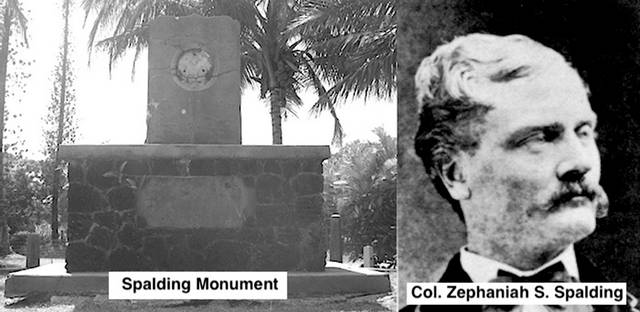On Sunday afternoon, April 20, 1930, dedication services chaired by K. Miyasaki and S. Takata were held at Kauai’s Spalding Monument, which had been recently erected by Japanese residents of Kealia in honor of former Makee Sugar Co. owner Colonel Zephaniah S. Spalding (1837-1927).
Spalding Monument was constructed of concrete and lava rock two miles above Kealia at the junction of what was then called the Government Road, now known as Kealia Road, and Valley House Road, presently designated Hauaala Road.
Mounted in the center on a large stone was affixed a plaque bearing the likeness of Colonel Spalding, and below that plaque, another plaque was attached bearing an inscription with the date of Spalding’s birth and death.
Nowadays, and for quite some time, perhaps since the 1990s, both plaques remain, but the likeness of Col. Spalding on one plaque, and the inscription on the other, have been defaced.
The principal speaker at the dedication was Philip L. Rice, who would become, in 1956, the last chief justice of the Supreme Court of the Territory of Hawaii.
He noted that Spalding’s father-in-law, Captain James Makee, founded Makee Sugar Co. in 1877, and upon the death of Makee in 1878, Spalding purchased majority interest in Makee Sugar Co. to become its owner and manager.
Rice also mentioned that Spalding sold the controlling shares of Makee Sugar Co. to Lihue Plantation in 1916 for $1,500,000 (about $34,000,000 in today’s dollars).
S. Takata, who’d been elected president of the Society of American Citizens of Japanese Ancestry of Kauai for 1925, then remarked that Spalding, born in Ohio, had commanded the 27thOhio Infantry during the American Civil War, and in 1867, had arrived in Hawaii as a secret agent of the United States with the mission of learning what effects a proposed reciprocity treaty would have on relations between the United States and the Hawaiian Kingdom.
I. Araki followed with a Japanese translation of Takata’s speech, and Spalding’s son, Rufus, thanked the Kealia Japanese for the monument erected to his father’s memory.




A week ago, in the context of President Trump’s White House state dinner for French President Macron, there were published reminders that the very first state dinner in the White House was staged by President Grant in honor of King Kalakaua in 1874. Kalakaua, newly elected as King, had journeyed to Washington to negotiate a reciprocity treaty whereby the U.S. would grant favorable tariff treatment for Hawaiian sugar imports in return for Hawaii giving the U.S. favorable treatment for exclusive use of Pearl Harbor as a naval base.
It is usually General Schofield who is targeted by Hawaiian sovereignty activists as being a secret spy for the U.S. regarding acquisition of Pearl Harbor. Wikipedia says “Schofield Barracks is named after Lieutenant General John McAllister Schofield, Commanding General United States Army August 1888 to September 1895. He had been sent to Hawaiʻi in 1872 and had recommended the establishment of a naval base at Pearl Harbor.” It makes sense to send the lower-ranking Colonel Spalding to Honolulu as a sort of “advance man” to scout Pearl Harbor for his boss General Schofield.
But it is ridiculous to portray either Spalding or Schofield as a “secret agent” or spy engaged in some sort of underhanded, illegitimate activity. The fact that newly installed King Kalakaua made a huge trip to Washington in 1874 (boat to California followed by 3000 mile railroad trip to Washington) clearly shows that negotiations regarding a reciprocity treaty had already been underway for many years, under King Kamehameha 5 and King Lunalilo. Just as happens today, someone considering whether to buy a property does “due diligence” and inspects the property before making an offer or signing a purchase contract. There was nothing at all improper about the Hawaii activities of either Colonel Spalding or General Schofield, which were probably conducted openly with full knowledge of Hawaiian government officials under 3 Hawaiian kings.
A few things are missing in this article ……..
First, the medallion image wasn’t defaced. It was removed by the Spalding family and taken back to Maui, Spaldings and Makees home town Ulupalakua, after the property was sold. The inscription plaque was somewhat defaced during WWII.
Secondly , How could Col. Spalding be accused of anything indecent, when there were 3 partners who owned Makee Sugar. King Kalakawa, Capt. Makee and Col. Spalding were partners in the ownership of Makee Sugar. Col. Spalding paid off the Makee heirs after his death and also bought out Kalakawa’s share in 1881 to become the sole owner.